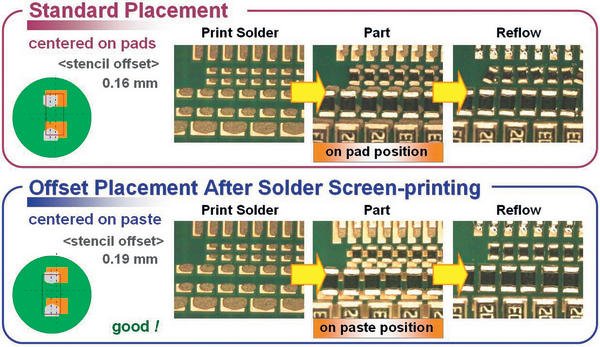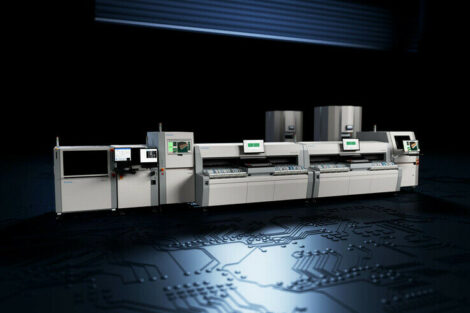Production companies will only be able to survive in the European market if they can clearly achieve a higher first yield quality and a higher efficiency than their competitors from low-wage countries. Juki focuses on the development of process controls and options within the SMD placement process in order to reach high quality reliability. The following report focuses on a cost-effective method to correct the variable screen printing offset within the SMD placement machine.
The demand for highly integrated circuits is increasing massively. Thus the SMD components are becoming smaller. The process window for 100 % first yield quality is getting ever smaller. With the universal introduction of lead-free solder paste the floating of components in the soldering oven is limited. Placing components on their position pre-defined by the CAD placement program no longer is the optimum solution as, due to several causes, screen printing offsets become more and more influential.
The problem
Board manufacturers try to reach a consistent and optimal quality standard. They do not always succeed though, as expansion and buckling within the circuit board can not be totally eliminated. This is especially true for very big boards or boards from low-wage production. This means that with small components the actual paste positions can easily differ by up to 50 % from the solder pads. With ceramic or flexible boards this problem is even more severe. In double-layer boards the 2nd side can show an even bigger distortion after having passed through the oven for the first side. The increased use of lead-free paste has strongly changed the floating behavior (self alignment effect). Consequences are bad soldering results due to displaced components, tombstones or Manhattan effects etc.
The solution
In co-operation with major customers and with intensive research Juki found out that placing smaller components on the paste position instead of the PAD position can massively lower the failure rate. Juki developed the Offset Placement After Screen Printing System technology in order to make use of this knowledge.
Video recordings made within soldering ovens proved that with the standard method of placing on the pads the components are shifted away by the melting solder paste and that this movement has an unpredictable behavior. Thus the components can not be soldered correctly and even tombstones and distortions can occur.
When using the Offset Placement After Screen Printing System method, the placement machine defines the screen print offset prior to the placement process for defined components and places with exact centering on the solder paste and not on the pad of the board. During the reflow process it can be seen how the components are floating onto the pad together with the solder paste in a controlled and consistent movement. This results in a much lower failure rate and a decisive increase of process security. The studies have also shown that this method is not suitable for big and heavy components, BGAs and fine pitch parts. It is highly recommendable for components smaller than 0803, though.
Conclusion
The integrated Offset Placement After Screen Printing System module within the placement machine eliminates the AOI system usually used in or after the screen printer in standard lines and saves a complicated communication with the placement machine for offset correction. This can massively minimise additional cost. Offset Placement After Screen Printing System is the solution for ongoing miniaturisation of circuits, the use of ever smaller components and the application of lead-free solder paste, combined with a simultaneous increase of process quality.
Productronica, Stand A5.143
EPP Europe 418
Share:










